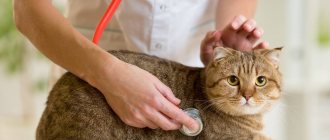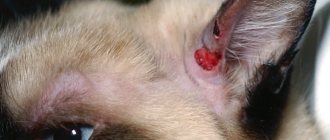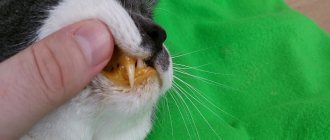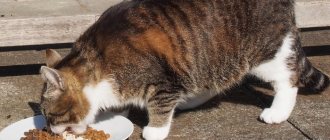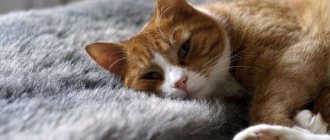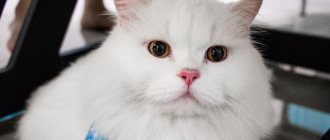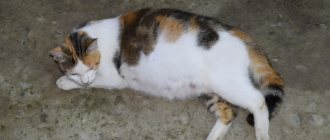Intestinal obstruction
- this is a complete or partial cessation of the movement of contents through the intestines. The most common cause is foreign body blockage. This is followed by blockage as a result of a tumor, volvulus, hernia or intussusception (penetration of one part of the intestine into another), etc.
Mechanical blockage with a foreign body reveals itself suddenly, out of the blue. How this happened a few days ago with my cat Avatar. Who is the cat Avatar and what is special about him - see here, it will be interesting.
Avatar During the day, vomiting suddenly began. At first I didn’t attach any importance to this. Well, I vomited once, who doesn’t? Again. Already alarmed. And I got really worried when the cat flatly refused to eat, without even looking towards the bowl. To test, she offered an impossible delicacy - a piece of chicken. Decisive refusal. Everything is bad!
Vomiting continued at night. And the next morning we were already at the clinic. They immediately took blood for analysis and put me on a drip without talking. Why?
Coprostasis in cats - what is it?
The name of the pathology consists of two Greek words: “kopros” (meaning “feces”) and “ktasis” (translated as “stop”). We can say that this is a pathology in which feces cannot move freely along their usual “route” in the intestines, as a result of which they begin to accumulate. This condition causes severe intoxication, which, in turn, is fraught with volvulus and ruptures. Note that as soon as you notice coprostasis in a cat, it must be eliminated immediately.
Why is obstruction dangerous?
- A cat's intestines are constantly working, pushing contents from the stomach to the anus. At the same time, the circulation of an important nutrient fluid continuously occurs: digestive juices produced by the stomach and intestines, during the work of the intestines, along with dissolved nutrients, penetrate through the walls back into the intestine.
When a blockage occurs, juices continue to be released, but now, unable to move and be absorbed, they accumulate in the stomach and small intestine, causing vomiting. With vomiting, a large amount of fluid and nutrients (especially potassium) is lost, rapid dehydration and weakening of the body occurs.
Drinking water does not help, but only makes vomiting worse. Without treatment within 2-7 days the animal will die.
Therefore, in case of serious disturbances in the functioning of the gastrointestinal tract (especially in case of obstruction!), abundant intravenous infusions are needed to replenish fluid.
- In addition, at the site of blockage, due to poor circulation in the affected area, necrosis may occur - tissue death of the intestinal wall, which will develop rapidly, which will also worsen the condition of the animal.
- And further. It happens that the presence of a foreign body in the intestines leads to its decomposition, oxidation, etc. and the release of toxic substances from it, which contributes to additional intoxication of the body.
- Obstruction (as well as chronic constipation) provokes the proliferation of putrefactive and other harmful bacteria, which leads to serious disruption of the intestinal microflora.
The closer the blockage is to the stomach, that is, the larger part of the intestine is closed, the more severe the disease.
Other causes of pathology
In kittens, helminths (a large number of them) can clog the intestines. These parasites completely block the lumen of the small intestine. This situation is extremely dangerous, as organ rupture or volvulus may occur. In addition, toxins are absorbed into the cat’s blood.
Another dangerous cause of coprostasis in cats is an intestinal tumor. Even if the formation is benign, it is very large. As a result, complete blockage of the intestinal lumen may occur, which will lead to the death of the animal.
It often happens that pathology occurs in animals that have undergone strip surgery. All this happens because a fairly common side effect of any such intervention is adhesions. If there are a lot of them, they can even crush the intestines. If the operation was performed on the intestines, then it also happens that the connective tissue directly grows into the walls of the organ. This leads to coprostasis in the cat.
Also, a similar pathology often occurs in long-haired animals. When they lick daily, they swallow a lot of fur.
Symptoms of obstruction
- increasing vomiting
- loss of appetite to the point of complete refusal to eat
- no or little stool
- deterioration of general condition
- painful enlarged belly
What to do? At the slightest suspicion of an obstruction (especially if you know that your pet had the opportunity to eat something “wrong”) - run to the clinic!
What not to do? Do not try to feed or water the cat - this will only provoke vomiting. Do not give an enema, as this may cause intestinal rupture. Do not give a laxative that increases contraction of the intestinal muscles. Do not use antiemetic drugs, which will only mask the symptoms without providing a therapeutic effect.
Coprostasis in cats: diagnosis by clinical signs
What signs indicate the presence of this pathology? How to determine coprostasis in cats? It is quite difficult to suspect this particular pathology. Since the first signs are very similar to severe constipation. The animal begins to grunt convulsively and growl when defecating. As a result of his “efforts,” he either does not succeed at all, or he produces feces in small portions in the form of thin ropes and ribbons. This already indicates that there is something in the animal’s intestines that prevents the normal movement of feces. Subsequently, the animal's condition worsens. The symptoms of coprostasis in the cat become more obvious. You can notice how she carefully pushes during the act of defecation, but at the same time she is unable to “squeeze” anything out. The cat loses its appetite and experiences severe symptoms of intoxication (including coma and neurological seizures). At the same time, she is apathetic and has a hard, bloated stomach.
About Vaseline oil
Vaseline oil is a purified fraction of petroleum without harmful organic substances and their compounds, mixes with fats and oils and has the properties of petroleum jelly. Without being absorbed into the walls of the gastrointestinal tract, it envelops the obstacle in the form of feces, softens them and facilitates the process of pushing. Indication: constipation. Contraindication: intestinal obstruction.
Here we come to a difficult dilemma: constipation or obstruction? With constipation, accumulation and hardening of stool usually occurs in the middle and lower intestines. And Vaseline oil is your first friend here. It can also help with partial obstruction.
In case of complete obstruction, the oil will aggravate the situation, becoming an additional burden in the gastrointestinal tract. In addition, it can “drag through” a foreign object a little, damaging the intestinal walls and causing their necrosis.
Thus, giving a cat Vaseline oil when there is a blockage is a risk: it may solve the problem, or it may worsen the situation.
Causes of pathology in cats
Why does this pathology occur? As a rule, the main reason is related to the cat's poor diet. More precisely, with eating foods that she shouldn’t eat at all. These include: synthetic sausage casings, fish and chicken bones, as well as other garbage. Such waste can completely clog the entire intestinal lumen. But fish bones are capable of breaking through the intestinal walls, which can lead not only to coprostasis in a cat, but also to peritonitis. It also happens that pathology occurs for other reasons. For example, chronic or infectious diseases of the gastrointestinal tract can provoke the appearance of coprostasis. Often these diseases lead to blockage of the bile ducts. As a result, the process of digesting food sharply worsens and intestinal motility decreases. This further leads to the occurrence of coprostasis.
Partial obstruction
With incomplete obstruction, part of the intestinal contents can pass through the obstruction, but with complete obstruction, not. With partial blockage, the animal can survive, while complete blockage poses a mortal danger.
Avatar Two years ago, with the same Avatar (oh, poor cat!) we experienced partial obstruction. Avatar opened the cabinet under the kitchen sink and gutted the trash can. For more than two weeks (!) the cat was lethargic, ate a little and only soft food, there was stool, but very scanty. An X-ray with contrast did not give an accurate result (50x50 - it seems like there is an obstacle, but the contrast agent seems to pass through it). I was given intravenous drips every day. The doctors were inclined to operate.
Deciding that there was nothing to lose anyway, I literally pumped the cat up with Vaseline oil (I had done this before, but not so decisively - there was no result). And Avatar finally produced such a bunch of sausage skins that it was impossible to imagine how it all fit in a small intestine, lay there for two weeks, and the cat lived with it! But imagine my amazement when the next day another similar pile came out. Just unbelieveble! Since then, we have kept the trash can under safe lock and key.
First aid
If you find that an animal has digestive problems, give it first aid. Limit your cat's food intake completely and give her fresh water regularly. No laxatives, especially saline laxatives, especially bisacodyl and other irritating drugs should not be given to your cat! Vaseline oil is relatively safe, but you should consult your doctor before using it. Cats do not like oil, and you will have to pour quite a lot of it, so make sure you have an assistant and good support for the animal. Unfortunately, petroleum jelly is effective only in mild cases when the stool is still soft. If your cat vomits after taking the oil, go to the doctor immediately!
Diagnosis of obstruction
With symptoms of acute obstruction, this dangerous disease is always ruled out first.
The diagnosis is made based on clinical symptoms and examination by a doctor. Careful palpation will determine the “acute abdomen” and painful area. Blood tests are needed to assess the cat's condition and identify concomitant diseases. If obstruction is suspected, an x-ray of the abdominal cavity, for better information, with a contrast agent.
If all these studies do not make it possible to make an accurate diagnosis, what remains is diagnostic laparotomy (as they say, “an autopsy will show”) - an incision in the abdominal cavity - a surgical operation under general anesthesia, which will reveal the pathology.
Avatar So, while we were dripping (2 hours, no less), the test results became ready. Everything is normal, with minor deviations that can be attributed to vomiting and hunger strike. A thorough examination by the doctor and palpation revealed a painful area in the abdomen. In general, the dire diagnosis of obstruction is becoming more and more clear. We go for an x-ray, having previously pumped ourselves up (20 ml) with a contrast agent.
Why is a contrast agent needed? In the animal's body, along with bone tissue, which gives a clear shadow picture during radiography, there is also soft tissue that creates a less dense shadow. Therefore, if tissues and organs are approximately the same in density, then their boundaries are difficult to distinguish on an x-ray. This also applies to the abdominal organs - liver, stomach, intestines, etc. How can we discern changes in them? For this purpose, substances with high atomic weight are used, creating a difference in density between the desired organ and the rest of the environment.
Barium sulfate is often used as a contrast agent for examining the gastrointestinal tract. It is a chemically pure, harmless, insoluble white powder, odorless and tasteless.
Avatar In the process of feeding the cat with a cocktail of water and barium, everything was smeared - the table, chair, floor, carrier, me, the doctor and, finally, the cat itself. It’s good that dried barium is easily cleaned like chalk.
Let's take a photo. And two things immediately become clear. Firstly, the cat was given barium in vain, because, secondly, even without contrast it is clearly visible that in the Avatar’s stomach lies... a metal clamp holding the skin on the end of the sausage. A week before Avatar, the Sphynx Ramses was in the clinic with symptoms of obstruction, from whom, as a result of an operation, the same end of the sausage was removed, and the doctors confidently identified its analogue in the picture of my cat. Here's a photo. The barium-filled stomach is clearly visible, followed by a wire curl:
Of course, no one deliberately gave him a dangerous “yummy.” It was just unwise to leave it on the table. The avatar himself cannot get anything from the table, but he has four-legged friends who helped him.
What to do? After consulting, we decide with the doctors to give Vaseline oil a chance, considering that it may work for my cat. Once again we drip for a long time, drink the oil and go home.
At home, the Avatar's condition worsens. He literally howls and starts vomiting again. My stomach is so bloated that I understand that Vaseline oil is not an option. After a disturbing night, we are at the clinic early in the morning. We dig in again and go to the operation.
Features of caring for a cat after surgery
After rectal prolapse surgery, your cat requires special care.
- The animal is prescribed an antibiotic and an analgesic to relieve pain in the postoperative period.
When treating cats, antibiotics such as Ciprovet, Tylosin, and Sinulox can be used.
- To prevent infection and licking of the cat's anus, special bandages and diapers are worn.
- After surgery, you need to keep the animal warm and avoid hypothermia.
- Compliance with a strict diet for animals: dry food and any products that provoke gas formation in the intestines are removed from the diet. Feeding is carried out frequently and in small portions. The doctor selects a more detailed feeding regimen based on the condition of the particular cat.
Treatment of obstruction
Treatment begins immediately, even before diagnosis. This includes infusion therapy (droppers) to replenish the loss of water and nutrients, painkillers and anti-inflammatory drugs, and antibiotics.
In severe cases, when intestinal blockage threatens the life of the animal, emergency surgery is indicated. Sometimes this involves removing the affected part of the intestine.
The postoperative period includes a fasting diet for 12-24 (sometimes more) hours, again intravenous drips, and antibiotics. Next - careful feeding with semi-liquid food. For 14 days it is necessary to monitor the condition of the sutures, which are then removed.
Avatar Avatar now has a “colleague” in the operation - a calico cat Monya, whose x-ray shows... the same foreign body as his. Ha-Ha! They go under the knife one after another.
I photographed the trophies after they were removed. Here they are. Avatarkin is on the left, Moni is on the right. Apparently, the sausage brace is a hit among foreign bodies in cats
The operation was successful, the sausage element was removed, there was no necrosis of the intestinal tissue - only two reddish dots from the metal pressure (that's what it means to react in time!). The avatar is resting. He was kept in hospital overnight. After recovering from anesthesia, he was prescribed an enema (a lot of feces had accumulated) and, of course, an IV.
Avatar, unlike other cats who have undergone surgery, does not need a post-op blanket because he cannot lick his belly. And a sick antibiotic can be given to him in the back muscle - there is no deep sensitivity. At least there are some advantages to paralysis.
The next day after the operation, the cat feels well, is active, moves his head, is interested in everything - cannot be compared with his recent state, when he was lethargic and apathetic. Morning and evening - endless droppers. Finally, after grabbing an infusion solution and an antibiotic, we go home. Hooray!
At home, the cat behaves as if there was no serious surgery. Let's dig on our own. How easy it is for doctors, and how difficult it is for a layman! We cope with sin in half.
I carefully begin to feed her with Royal Canin Recovery pate (1-2 teaspoons every 2-3 hours). The appetite is excellent. The whole family breathed a sigh of relief. We rejoice. But in vain!
By the evening of the next day - complete refusal of food. In the morning we go to the clinic again. We donate blood and sit down to take a bath. The tests are normal, the treatment is drips, drips and more drips. The antibiotic continues in a continuous course. By evening the cat begins to eat.
At home now. We continue IVs, antibiotics, soft nutrition. The avatar feels great and is already chasing cats. True, he’s still weak, he rests a lot, but that’s normal. The seam is fine, although slightly dented. It looks like the obstruction story is coming to an end. Pah-pah-pah...
Do you think she will teach the Avatar something and he will learn some lesson? No matter how it is! If someone drew conclusions, it was not the victim, but his owners, that is, us.
Treatment of pathology. What is used for this disease?
Now let's talk about the treatment of coprostasis in cats. How is therapy carried out? It all depends on what caused the illness. Surgery can remove pieces of bone, overgrown adhesions and tumors. Even neoplasms that respond well to chemotherapy simply do not have time to “etch out”, and caked pieces of feces still need to be removed from the intestines. If the pathology occurs due to a large number of helminths, then drugs against parasites are prescribed. Specific therapy will also be required to restore the gastrointestinal tract after illness. In addition, in all cases an enema with oils and Glauber's salt is prescribed. Such procedures soften dehydrated and stagnant pieces of feces. In no case should you immediately prescribe strong laxatives; this is strictly prohibited, since in this case there is a risk of intestinal rupture in the animal.
Preventing constipation
Prevention of constipation in cats by animal owners should be based on preventing the causes that cause constipation in cats. Cat owners should:
- Constantly comb the cat's hair; buy a special paste to remove the hair and constantly swallow it.
- Exclude small and soft bones from the diet, which can be a source of traumatic intestinal damage to the cat.
- Make your cat move and play more so that exercise becomes the norm for her.
- Regularly deworm your cat.
- When feeding dry food, the cat should have free access to water.
- Add foods rich in fiber to your cat's diet.
- Prevent your cat from injuring the pelvis and spine.
- Get frequent flea prevention.
- Regularly vaccinate your cat against viral infectious diseases common in your region.
Take your cat for preventive examinations to the veterinary clinic.
Actions of the owner in case of suspected bloat
If it is noticed that your pet has eaten some inedible object, or symptoms reminiscent of signs of bloat are observed, then you should immediately take the mustachioed creature to the veterinary clinic for an x-ray and examination.
What not to do:
- Offer your pet treats, let alone force feed her.
- Give the purr antiemetic drugs.
- Offering your cat drugs with a laxative effect can aggravate the problem and cause complete rupture of the intestine.
Treatment of rectal prolapse in a veterinary clinic
Depending on the complexity of the situation, the doctor, after examination, decides whether to use gentle conservative methods or transfer the cat to the surgical department for surgery. Treatment options:
- if the prolapse is insignificant, there are no signs of edema and necrosis, then a piece of intestine is treated with antiseptics under local anesthesia, lubricated and set. This manipulation is performed in a single case of prolapse as a result of accidental constipation. In the future, normalization of the cat’s nutrition and maintenance prevents repeated loss;
- placing a purse-string suture on the anus to prevent recurrent prolapse of the reduced intestine;
- suturing part of the intestine to the abdominal wall;
- resection of the strangulated and necrotic area is carried out only under general anesthesia.
At the RosVet VC, experts recommend leaving the cat after the operation for 2-5 days in the clinic’s hospital in order to observe the animal, administer the prescribed medications (anti-inflammatory, painkillers, antibiotics) and remove the external sutures. To minimize the risk of licking the anal area, wear a protective collar or diaper on the cat.
It is mandatory to prescribe a diet, eliminating all foods that can cause constipation or, conversely, profuse diarrhea. If defecation is difficult, herbal laxatives are given to completely eliminate straining and recurrent bowel prolapse.
Symptoms
The fundamental sign of intussusception is vomiting. At the same time, the animal makes it clear with its plaintive meows that it is in extreme pain. Other manifestations that will let the pet owner know that the animal should be taken to the veterinary clinic immediately are:
- Sudden changes in behavior - the patient's apathy and dejection, or vice versa, the mustache's constant running from place to place as a way to attract attention to itself.
- Refusal of treats, because the mustache understands that with food it will become even worse.
- The urge to vomit or the immediate appearance of vomit (often interspersed with blood).
- A sick mustache does not allow him to touch his tummy (it becomes hard and inflated) - this gives him acute pain.
- Gases accumulate in the cat's body, so the mustache may begin to roll on the floor, trying to free itself from them.
- The patient does not defecate - the absence of feces in the tray for a long time can be both a sign of constipation and obstruction. But if in the first case, the cat can still sometimes go to the toilet, then with volvulus in cats, in addition to the listed symptoms, there is a complete absence of bowel movements (surgical intervention is necessary).
- Shock state - nutrients and oxygen do not reach the intestines, this situation leads to hypovolemic shock.
- The patient's body becomes dehydrated and therefore the mustache literally dries out before our eyes (its body weight decreases).
